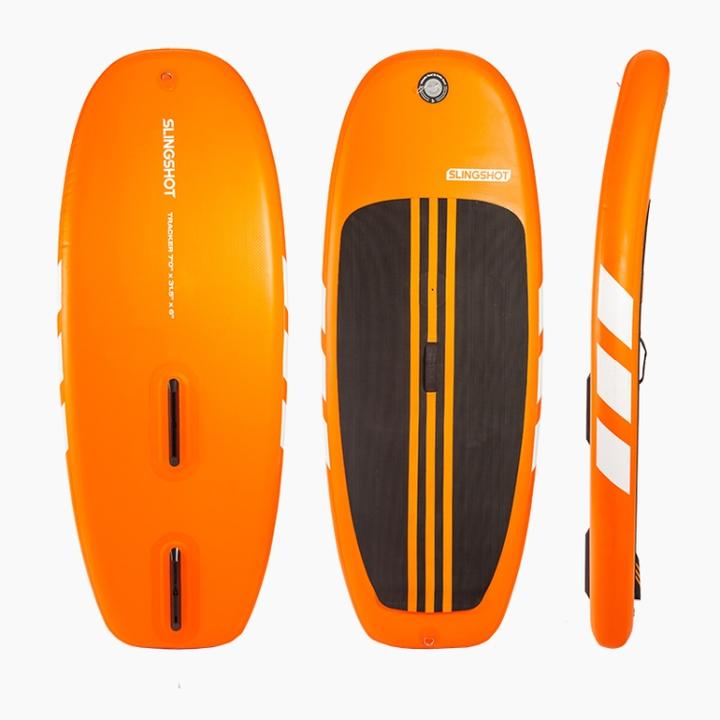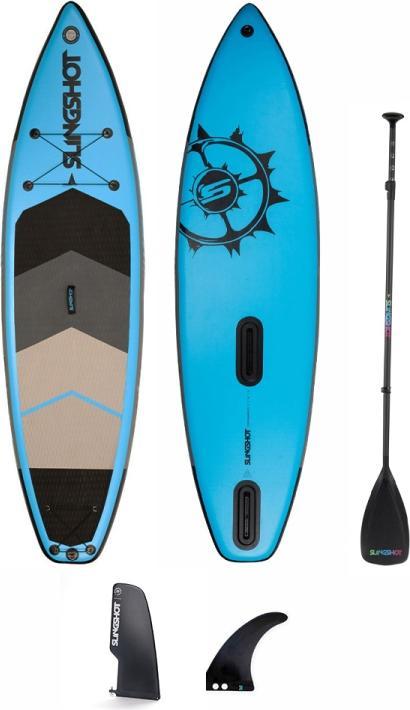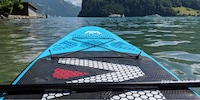

Gliding across the water – my first attempts at wing SUPing
When I witnessed the first wing foilers in Hawaii about five years ago, I was mesmerised. They looked so beautiful and elegant with their oversized wings. I’ve been dreaming of trying it ever since. So I did.
There are some things that are incredibly appealing to me. Wing foiling is one of them. That is, gliding almost weightlessly over the water with a sail on a hydrofoil board. But my inner voice of reason reminds me it’ll take me forever to learn it. What’s more, you need a lot of wind blowing constantly from one direction. That rarely happens in Switzerland. And so, the voice of reason has always triumphed.
Until now. When I came across the Slingshot Blaster wing and matching inflatable Slingshot Tracker board, I seized the opportunity. Why? Because wing SUPing offers a good introduction to wing foiling. It’s easier to learn and can be done even in light winds. I can literally hear my voice of reason getting quieter. It’s decided: I’ve got to at least give wing SUPing a go.

What exactly is a wing SUP?
Wing SUPing involves, as the name suggests, using a wing to catch the wind and glide along the water on an SUP. You don’t need a foil board, that is, a board that at sufficiently high speeds lifts out of the water to glide on the foil, or carbon wing. You can use your SUP,
so all you need to buy is a wing. I decided to test the Slingshot Tracker board with the wing instead of my touring SUP, because it’s shorter and therefore more manoeuvrable. It also has an additional long, wide centre fin that makes it easier to stay on course than a board that only has a tail fin. Of course you can now ask why I didn’t reach for a foil board right away and try it with the wing but without the foil. Compared to a foil board, an SUP – or in this case, the Slingshot Tracker – is very stable and has more volume, which makes it easier to stand up and then stay standing with the wing.
The best way to get started
Wing SUPing is a game with the elements. In addition to the forces of the water and the wind, you also need to have the wing and SUP under control. That’s why I really recommend booking a course with a professional to get started. On the water, like on the road, certain rules apply. During your lesson, you’ll learn what to look out for, where the conservation and restricted areas are, who has the right of way, and how to get on and off the lake safely. Not to mention doing a course will save you from tedious self-experimentation that’s likely to have you ending up in the water or even on the other side of the lake.
I knew who I absolutely insisted on being my teacher: Dani Reinhart, who, together with his wife Nici, runs the Honu centre for water sports at Lake Thun. Dani knows his way around the water like no one else. He started windsurfing as a child, later experiencing success in international SUP races and adding wakeboarding to the mix. Wing foiling, foil pumping and wake foiling are the latest water sports Dani is pioneering. So, I took the plunge and booked a lesson.
At first I thought, «No way this is happening today. There’s not nearly enough wind.» But I was wrong. After a brief theoretical intro, we headed into the water. It wasn’t long before I had the wing under enough control to glide over the water, propelled by light wind. How fun! How cool! I even managed to steer. Not long after, I also managed to turn and jibe thanks to Dani’s instruction, who bobbed alongside me in a boat, correcting my posture and technique. Without Dani’s live tips and instruction, it would have taken me weeks to get this far. I am honestly surprised that I was able to stand up and sail along during my first lesson ever.
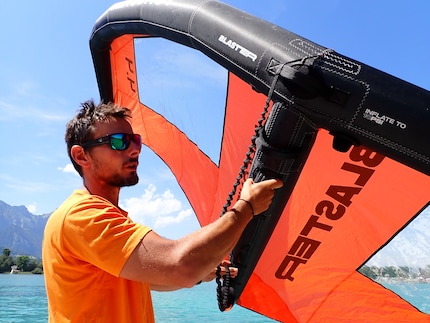
Source: Siri Schubert
The Slingshot Blaster wing – good for beginners
With that, I had achieved my first goal: gliding over the water with a wing and SUP. But I also wanted to test if the Slingshot Blaster and Slingshot Tracker Board were really as easy to use as the manufacturer claimed. After all, it’s touted as a beginner-friendly wing that works even in light winds. Furthermore, it’s supposed to be suitable for everyone, regardless of height and weight.
My first impression is that yes, this is all true. The Slingshot Blaster really is a wing for beginners. What makes it so beginner-friendly, you ask? The first thing I noticed were the strategically placed large transparent panels – windows, if you will – that allowed me to see what was happening around me. This is an ingenious feature, especially for the inexperienced. It allows you to keep an eye on your surroundings and take early evasive action should you get too close to a boat or a fellow water sports enthusiast.
The integrated leash that connects your wrist and wing is elastic, and its neoprene cuff is comfortable. This is definitely a pro. The handles are also stable, so your hand movements transfer well to the wing. However, I would have liked an additional handle in the middle to have more options for holding the wing.
The front tube (leading edge) and centre tube can be inflated up to 10 PSI (0.7 bar) each, making the wing very stiff and easy to control. Its size of 4.4 square metres makes the wing suitable for use even in low wind.
What strikes me – and even more so my instructor Dani – is just how many handling errors it forgives. Even if I accidentally dip the tips of the wing in an attempt to position them just above the water, the wing doesn’t immediately flip over. As a result, I really had fun – and surprisingly didn’t land in the water.
The Slingshot Tracker board – great stability
Part of my success is due to the Slingshot Tracker SUP, a 7-foot-long (2.13 metres), 80-centimetre-wide inflatable board. The board offers enough volume and stability for me to concentrate on handling the wing instead of keeping my balance. Even waves from a passing motorboat don’t throw me overboard. The stripes on the board mark the centre, helping me to position my feet. The fact that it’s an inflatable board and therefore softer than a hard board is also an advantage; it reduces the risk of injuring yourself or others if you fall or collide.
A feature I think is super neat are the two fins. The long centre fin has a large surface area and helps me keep the board on course when wind SUPing so that it doesn’t immediately spin and ride away with the wind. Unfortunately, the rear fin – a click fin – doesn’t sit optimally in the fin box. I would have preferred a screw-in fin, which doesn’t fall out and won’t get lost quite as easily.
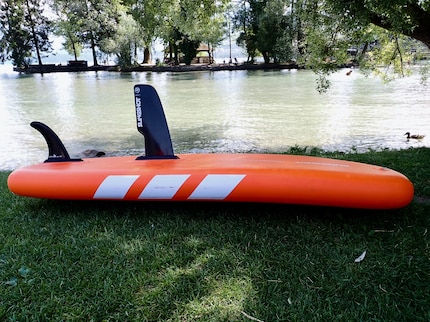
Source: Siri Schubert
Who’s the Slingshot Tracker suitable for?
The inflatable board is ideal for beginners to wing SUPing. You also have the option to screw in a windsurfing mast, allowing you to use the board in yet another way. I haven’t tried that out yet. And although a paddle is also included in the package, I wouldn’t recommend the board to adults for stand-up paddling due to its short length. It’s too short and too round to cover longer distances. When it comes to SUPs, a longer length gives you more speed.
But if you plan to use the board mainly with the wing – and maybe have children or teenagers in the family who also like to paddle – it’s a solid choice. Otherwise, I’d consider getting a longer board that you can also use as an SUP, like the 11-foot (3.35-metre) Slingshot Crossbreed.
Final thoughts
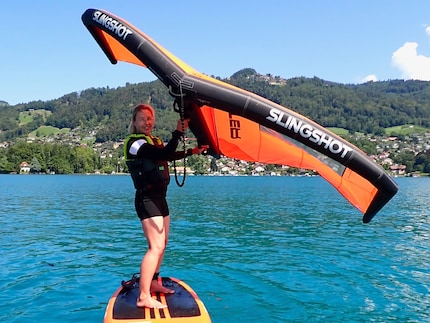
Source: Dani Reinhart
Wing SUPing is fun! And with the right guidance from an experienced instructor and good beginner equipment, it’s not as hard to learn as I thought. The Slingshot Blaster is beginner-friendly and can be used even in low wind, so you can start slow and gradually go out in stronger wind. Of course, the Blaster isn’t a professional wing – and it’s much cheaper than a high-performance wing. The Slingshot Tracker board works really well in combination with the wing. However, I wouldn’t recommend it as an SUP for adults who want to paddle longer distances.
As for me, I’m definitely going to practise some more and then try my hand at wing foiling. If things continue well with wing SUPing, the logical next step for me is to one day glide noiselessly with elegance over the water – like my role models did in Hawaii.
Header image: Dani Reinhart
Research diver, outdoor guide and SUP instructor – I love being in, on and around water. Lakes, rivers and the ocean are my playgrounds. For a change of perspective, I look at the world from above while trail running or flying drones.
